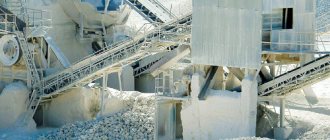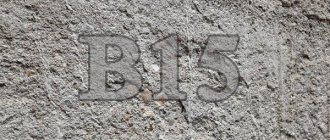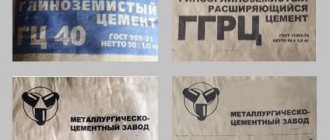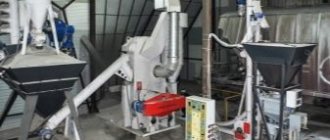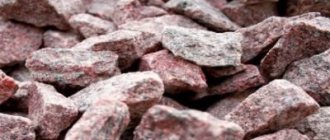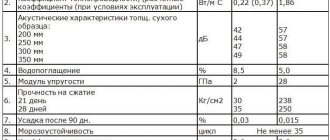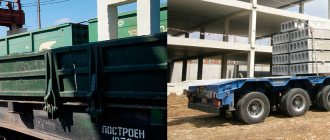When constructing a residential building or industrial structures, a material such as cement is actively used. It is its quality that determines how long the building will last. When choosing this material, it is necessary to take into account such parameters as good adhesion, components included in the composition and physical properties, technical characteristics in accordance with GOST. Today on the market you can find cement such as M400. It belongs to the type Portland cement. It is actively used in various fields of construction due to its high qualities, which we will consider further.
INFORMATION DATA
1. DEVELOPED AND INTRODUCED by the Ministry of Construction Materials Industry of the USSR
DEVELOPERS
Z.B. Entin, Ph.D. tech. sciences; L.A. Malinina, Doctor of Engineering. sciences (topic leaders); E.T. Yashina; KBKpacnova; M.I. Brusser, Ph.D. tech. sciences; N.E. Mikirtumova; A.B. Morozov.
2. APPROVED AND ENTERED INTO EFFECT by Resolution of the USSR State Committee for Construction Affairs dated July 10, 1985 N 116
3. THE STANDARD IS FULLY IN COMPLIANCE WITH ST SEV 5683-86
4. INSTEAD GOST 10178-76
5. REFERENCE REGULATIVE AND TECHNICAL DOCUMENTS
| Designation of the referenced technical document | Number of paragraph, subparagraph | Designation of the referenced technical document | Number of paragraph, subparagraph |
| GOST 310.1-76 | 3.1 | GOST 5382-73 | 3.2 |
| GOST 310.2-76 | 3.1 | GOST 6613-86 | 1.10 |
| GOST 310.3-76 | 3.1 | GOST 22236-85 | 1.14, 2.1, 3.4 |
| GOST 310.4-81 | 3.1 | GOST 22237-85 | 4.1 |
| GOST 3476-74 | 1.5 | GOST 23464-79 | Introductory part, 1.2 |
| GOST 4013-82 | 1.5 | ST SEV 4772-84 | Introductory part |
6. REISSUE (October 1990) with Change No. 1, approved in April 1988 (IUS No. 8-88).
Change No. 2 was introduced, approved by Decree of the State Construction Committee of Russia dated December 28, 1998 No. 15 and put into effect from January 1, 1999.
Amendment No. 2 was made by the legal bureau "Code" according to the text of "BLS" No. 1, 1999.
An amendment was made, published in IUS No. 6, 2001
The amendment was made by the database manufacturer according to the text of IUS N 6, 2001
This standard applies to cements for general construction purposes based on Portland cement clinker.
The standard does not apply to cements that have special requirements and are manufactured according to the relevant standards and specifications.
Classification, terms and definitions - according to GOST 30515-97.
(Changed edition, Amendment No. 2).
Scope of application
M400 grade cement is suitable for general construction and finishing works:
- Arrangement of all types of foundations (strip, pile, slab);
- Construction of walls and columns;
- Preparation of plaster and repair mortars;
- Mixing concrete for laying paths.
From cement m 400, concrete M100...M450 is obtained. Moreover, the lower the grade of concrete, the lower the consumption of binder compared to the total volume of components. The mixing proportions are shown in the table:
| Expected grade of concrete | Proportions by weight (kg) C:P:SH* | Proportions by volume per 10 l PC (l) P:SH | Concrete yield from 10 liters of PC (l) |
| M450 | 1 : 1,1 : 2,5 | 10 : 22 | 29 |
| M400 | 1 : 1,2 2,7 | 11 : 24 | 31 |
| M300 | 1 : 1,9 : 3,7 | 17 : 32 | 41 |
| M250 | 1 : 2,1 : 3,9 | 19 : 34 | 43 |
| M200 | 1 : 2,8 : 4,8 | 25 : 42 | 54 |
| M150 | 1 : 3,5 : 5,7 | 32 : 50 | 64 |
| M100 | 1 : 4,6 : 7,0 | 41 : 61 | 78 |
*C – cement, P – sand, Shch – crushed stone.
TECHNICAL REQUIREMENTS
1.1. Cement must be manufactured in accordance with the requirements of this standard according to technological regulations approved in the manner established by the manufacturer's ministry.
1.2. Based on their material composition, cement is divided into the following types:
Portland cement (without mineral additives);
Portland cement with additives (with active mineral additives no more than 20%);
Portland slag cement (with additions of granulated slag more than 20%).
(Changed edition, Amendment No. 2).
1.3. Based on compressive strength at 28 days of age, cement is divided into grades:
Portland cement - 400, 500, 550 and 600;
Portland slag cement - 300, 400 and 500;
quick-hardening Portland cement - 400 and 500;
quick-hardening Portland slag cement - 400.
Note. It is allowed, with the permission of the USSR Ministry of Construction Materials, to produce Portland cement with mineral additives of grade 300.
1.4. The symbol for cement should consist of:
Names of cement type - Portland cement, Portland slag cement. It is allowed to use an abbreviated designation of the name - PTs and ShPTs, respectively;
grades of cement - according to clause 1.3;
designations of the maximum content of additives in Portland cement according to clause 1.6: D0, D5, D20;
designations of fast-hardening cement - B;
designations for plasticization and hydrophobization of cement - PL, GF;
designation of cement obtained from clinker of standardized composition - N;
symbols of this standard.
An example of a symbol for Portland cement grade 400, with additives up to 20%, quick-hardening, plasticized:
Portland cement 400-D20-B - PL GOST 10178-85.
The following designation is allowed (except for cases of supply of cement for export):
PC 400-D20-B - PL GOST 10178-85.
1.5. In the production of cements the following is used:
clinker, the chemical composition corresponding to the technological regulations. Mass fraction
Magnesium oxide (MgO) in clinker should not be more than 5%.
For individual enterprises, according to the list established by the USSR Ministry of Construction Materials, due to the peculiarity of the chemical composition of the raw materials used, the MgO content in clinker is allowed to exceed 5%, but not more than 6%, provided that uniform changes in the volume of cement are ensured when tested in an autoclave;
gypsum stone according to GOST 4013-82. The use of phosphogypsum, borogypsum, fluorogypsum is allowed in accordance with the relevant regulatory and technical documentation;
granulated blast furnace or electrothermophosphorus slags in accordance with GOST 3476-74 and other active mineral additives in accordance with the relevant regulatory and technical documentation;
additives that regulate the basic properties of cement, and technological additives in accordance with the relevant regulatory and technical documentation.
1.6. The mass fraction of active mineral additives in cements must correspond to the values indicated in the table. 1.
Table 1
| Active mineral additives,% by weight | ||||
| Designation of cement type | Total | Including | ||
| blast furnace granulated and electrothermophosphorus slags | sedimentary origin, except gliège | other actives, including gliezh | ||
| PC-D0 | Not allowed | |||
| PC-D5 | Up to 5 | Up to 5 | Up to 5 | Up to 5 |
| PC-D20, PC-D20-B | St.5 to 20 | Up to 20 | To 10 | Up to 20 |
| ShPTs, ShPTs-B | St. 20 to 80 | St.20 to 80 | To 10 | To 10 |
It is allowed to replace part of the mineral additives in all types of cement with additives that accelerate hardening or increase the strength of cement and do not impair its construction and technical properties (rents, sulfoaluminate and sulfoferritic products, calcined alunites and kaolins). The total mass fraction of these additives should not be more than 5% of the cement mass.
1.7. The tensile strength of cement in bending and compression must be no less than the values indicated in table. 2.
table 2
| Designation of cement type | Guaranteed | Tensile strength, MPa (kgf/sq.cm) | |||
| brand | when bending at age, days | with compression at age, days | |||
| 3 | 28 | 3 | 28 | ||
| PC-D0, PC-D5, | 300 | — | 4,4 (45) | — | 29,4 (300) |
| PC-D20, ShPTs | 400 | — | 5,4 (55) | — | 39,2 (400) |
| 500 | — | 5,9 (60) | — | 49,0 (500) | |
| 550 | — | 6,1 (62) | — | 53,9 (550) | |
| 600 | — | 6,4 (65) | — | 58,8 (600) | |
| PC-D20-B | 400 | 3,9 (40) | 5,4 (55) | 24,5 (250) | 39,2 (400) |
| 500 | 4,4 (45) | 5,9 (60) | 27,5 (280) | 49,0 (500) | |
| ShPTs-B | 400 | 3,4 (35) | 5,4 (55) | 21,5 (220) | 39,2 (400) |
The manufacturer must determine the steaming activity of each batch of cement.
1.2-1.7. (Changed edition, Amendment No. 1).
1.8. The cement must show a uniform change in volume when testing samples by boiling in water, and when the MgO content in the clinker is more than 5% - in an autoclave.
1.9. The beginning of cement setting should occur no earlier than 45 minutes, and the end should occur no later than 10 hours from the start of mixing.
1.10. The fineness of cement grinding must be such that when sifting a cement sample through a sieve with mesh N 008 in accordance with GOST 6613-86, at least 85% of the mass of the sifted sample passes.
1.11. The mass fraction of sulfuric acid anhydride (SO(3)) in cement must comply with the requirements of Table. 3.
Table 3
| SO(3), % by mass | ||
| Designation of cement type | No less | No more |
| PC 400-D0, PC 500-D0, PC Z00-D5, PC 400-D5, PC 500-D5, PC 300-D20, PC 400-D20, PC 500-D20. | 1,0 | 3,5 |
| PC 550-D0, PC 600-D0, PC 550-D5, PC 600-D5, PC 550-D20, PC 600-D20, PC 400-D20-B, PC 500-D20-B | 1,5 | 4,0 |
| ShPTs 300, ShPTs 400, ShPTs 500, ShPTs 400-B | 1,0 | 4,0 |
1.12. It is allowed to introduce special plasticizing or water-repellent surfactant additives into cement during its grinding in an amount of no more than 0.3% of the cement mass in terms of the dry substance of the additive.
Plasticized or hydrophobic cement should be supplied by agreement between the manufacturer and the consumer.
Plasticized or hydrophobic cement should not be supplied to consumers who use superplasticizers in the preparation of concrete mixtures.
The mobility of a cement-sand mortar with a composition of 1:3 from plasticized cements of all types must be such that, with a water-cement ratio of 0.4, the spread of a standard cone is at least 135 mm.
Hydrophobic cement should not absorb water within 5 minutes from the moment a drop of water is applied to the surface of the cement.
1.13. When producing cement to intensify the grinding process, it is allowed to introduce technological additives that do not impair the quality of cement in an amount of no more than 1%, including organic additives of no more than 0.15% of the cement mass.
The effectiveness of the use of technological additives, as well as the absence of their negative impact on the properties of concrete, must be confirmed by the results of tests of cement and concrete.
1.14. For concrete road and airfield pavements, reinforced concrete pressure and free-pressure pipes, reinforced concrete sleepers, bridge structures, racks of high-voltage power transmission lines, contact networks of railway transport and lighting, cement must be supplied based on clinker of a standardized composition containing tricalcium aluminate (C(3) A) in an amount not exceeding 8% by weight.
For these products, in agreement with the consumer, it is necessary to supply one of the following types of cement:
PC 400-D0-N, PC 500-D0-N - for all products;
PC 500-D5-N - for pipes, sleepers, supports, bridge structures, regardless of the type of additive (for pressure pipes, cement of group I or II for steaming efficiency must be supplied according to Appendix A);
PTs 400-D20-N, PTs 500-D20-N - for concrete road and airfield pavements when using granulated slag as an additive of no more than 15%.
The beginning of setting of Portland cement for concrete road and airfield pavements should occur no earlier than 2 hours, Portland cement for pipes - no earlier than 2 hours 15 minutes from the start of cement mixing. By agreement between the manufacturer and the consumer, other setting times are allowed.
The specific surface area of Portland cement with the addition of slag for concrete road and airfield pavements must be at least 280 sq.m/kg.
1.12, 1.14. (Changed edition, Amendment No. 1, Amendment No. 2).
1.15. Mass fraction of alkali oxides (Na(2)O and K(2)O) in terms of Na(2)O (Na(2)O + 0.658 K(2)O) in cements intended for the manufacture of massive concrete and reinforced concrete structures using reactive filler, installed in agreement with the consumer.
1.16. The mass fraction of alkali oxides in cements produced using belite (nepheline) slurry, calculated as Na(2)O, should not be more than 1.20%.
(Changed edition, Amendment No. 1).
1.17. (Deleted, Amendment No. 2).
1.18. The manufacturer must test cement for signs of false set evenly throughout shipment, but not less than 20% of shipments.
(Introduced additionally, Amendment No. 1).
Where is the mixture used?
M400 GOST 31108 2003 is a well-known composition that is simply irreplaceable in hydraulic engineering and transport construction. It is actively used in the construction of underground and above-ground facilities, houses and structures located under water and in mineral waters.
The presented mixture has been widely used in the manufacture of reinforced concrete structures, and is also very popular among Russian and foreign builders. And this is not surprising, because the M400 outperforms other brands in many respects.
You can find out what expanding cement GOST 11052 74 is from this article.
Since cement does not corrode when in contact with a sulfate environment, it can be used in the production of various building mixtures, including sand-cement mixtures. It should be noted that different materials may have differences in the process of use.
What is the specific gravity of cement can be found in this article.
TEST METHODS
3.1. Determination of the physical and mechanical properties of cements is carried out according to GOST 310.1-76 - GOST 310.3-76, GOST 310.4-81.
3.2. Chemical analysis of clinker and cement is carried out according to GOST 5382-73.
In this case, the mass fraction of magnesium oxide (MgO) in clinker is established according to production acceptance control data.
3.3. The type and amount of additives in cement are determined according to the methodology of the parent organization for state testing of cement in a sample taken at the manufacturing plant.
3.4. (Deleted, Amendment No. 2).
3.5. The presence of signs of false setting of cement is checked according to the methods of the parent organization for state testing.
(Changed edition, Amendment No. 1).
3.6. (Deleted, Amendment No. 1).
Advantages and disadvantages
The advantages of the M400 include the following features:
- high strength properties;
- resistance to moisture, temperature fluctuations, corrosive wear;
- duration of service life of reinforced concrete products;
- possibility of use in different climatic zones, without adding antifreeze components to the solution;
- wide scope of application. M400 can be used both for finishing (plastering) work and for the construction of masonry and reinforced concrete structures;
- the cost of this type of cement is lower than the price of higher grades.
As for the disadvantages, the M400 has only one - it is not strong enough to be used in the construction of high-rise buildings.
Classification by impurity content
Cement m400 d20, d5, d0 is common on the building materials market, the characteristics of which differ depending on the ratio of special additions and impurities.
Composition and marking of cement M400 according to GOST:
- D20 – the volume of additions to the total volume of the mixture is 20%;
- D5 – the content of additives to the total volume of the mixture is 5%;
- D0 – pure consistency without impurities.
Depending on the manufacturer, the composition of M400 cement can contain both anti-sulfate mineral additives and mineral admixtures that increase the plasticity of the total mass or its frost resistance.
What should you consider before purchasing?
Storage conditions also play a significant role . The material must be in a dry place, since if moisture gets into it, it will turn into mineral chips, unsuitable for use.
Storage
When purchasing cement, you should first of all pay attention to the release date. The longer the material is stored, the worse its quality becomes, resulting in a lower grade of the product. Therefore, when purchasing stale goods, there is a risk of receiving an M300 at the price of an M400.
Following these simple recommendations will help you purchase high-quality Portland cement M400, which can be characterized as a universal material suitable for use for various purposes .
Manufacturing
What is cement made from, what is its composition? The production of this brand of cement is regulated by GOST No. 10178, approved in 1985. In 2003, the document was updated to GOST 31108, which does not completely cancel, but only supplements the provisions of the previous one.
Manufacturing the material in accordance with the current standard allows us to obtain a product that is not inferior in quality to products manufactured in the EU and CIS countries.
M400 is made from crushed clinker (obtained by firing limestone and clay), which is mixed with gypsum and special impurities. The M400 marking means that after hardening the solution is able to withstand loads of up to 400 kgf per cm2.
Prices for cement grade M-400
Prices for the final product, M-400 cement, are made up of production costs, transport and overhead costs, and wholesale and retail trade markups.
Average prices for the sale of cement in bulk are 2800...5000 rubles/ton ; a bag of industrial cement weighing 50 kg costs 230...400 rubles/kg. The price range depends on the delivered batches of goods, their distance from the place of production and the sales markup of sellers.
Cement with mineral additives or Portland cement costs on average 10...15% more. A product with slag components will cost 5...10% less, but it is recommended to use it for the production of concrete, which is used for non-critical building structures, for example, for pouring sidewalks, making road tiles, curb stones.
The most popular type of binder in civil engineering is M400 cement. It has technical characteristics and operational properties sufficient to ensure the strength and reliability of the load-bearing structures of houses, outbuildings and industrial buildings.
Labeling of cement products for different delivery methods
It’s one thing when the cement mortar is prepared at the work site. When the raw material is imported, its brand is known, it is clear what the ratio is, and for what types of work it is used. It’s another matter when products need to be delivered to the customer. How should products be labeled?
When shipped, cement 300-400 can be distinguished by the markings applied to the packaging or by the accompanying documents, where the corresponding mark is made. Shipment can be carried out from the manufacturer in two ways:
By car:
- in bulk;
- packaged.
By rail in special wagons – Khoprakh:
- in bulk;
- in packaging: carriages with access inside.
Delivery by car
The container in which the products are packaged must be marked with the product: M-300 or M-400 indicating the purity of the product, its use and date of manufacture. If raw materials are moved in mixers, the brand of the product is indicated in the accompanying documents. Also weight and consignee.
Delivery by rail
When transporting by hoppers (in bulk), a note is made in the railway waybills about the weight and marking of the goods: “Cement grade M-300.” In covered wagons, when transporting packaged goods, the railway waybills contain a corresponding mark on the number of pieces and the total weight indicating the brand of the product.
With the development of the construction industry, ready-made mixtures of different compositions are used. New types of binding substances are emerging. The old and weak are gradually leaving the construction market. Production of M-110 and M-200 ceased. The 400 brand is gradually squeezing out the 300 brand.
Both brands are used to prepare solutions. Used during construction work. We have already discussed how to distinguish 300 cement from 400 cement at a construction site, as well as during transportation. I would like to add that they have practically no differences. They are akin to twin brothers. Only one of them is a little older. The 400 has a larger area of use. M-300 has interior decoration and exterior decoration of buildings. Even when laying bricks, if there are two types, they choose the more resistant 400th. Their main difference from each other is the degree of compression. Naturally, the 440th is higher than the 300th. Find out also why M700 cement is better than other materials by clicking on this link.
Cement production. Features of technological processes
There are three main types used in cement production:
- wet;
- dry;
- combined.
Wet production method
Based on the preparation of raw materials by grinding components in water.
Stages:
- Natural minerals, - limestone and clay are crushed in an aqueous environment.
- The resulting mixture , which has up to 50% humidity, is loaded into a kiln.
- Raw materials are subjected to heat treatment in several zones: heating and drying, - at a temperature of 200...600°C, excess moisture is removed, organic inclusions burn out, chemicals undergo dehydration, followed by the breakdown of components into oxides;
- decarbonization zone – limestone decomposes into calcium oxide with the release of carbon dioxide; under the influence of temperatures in the range of 900…1200°C, new chemical substances are formed;
- zone of thermal reactions - the final formation of chemical substances and their partial sintering occurs;
- sintering zone – at a temperature of 1350...1480°C clinker granules are formed;
- cooling zone – cooling of raw materials with a slow decrease in temperature to 1300°;
Dry production method
The most economically advantageous method. The difference from the “wet” production method is that at all stages of processing the materials are in dry form.
Stages:
- The initial raw materials - limestone, chalk, clay, coal - go through the crushing stage in crushing machines.
- Next comes the drying stage in a tumble dryer.
- The components are crushed and mixed, followed by moistening.
- The resulting mixture goes through the granulation stage.
- The granulated product is fired in a mechanized shaft furnace.
- The clinker mixture is shipped to a warehouse, where it is crushed and mixed with additional components.
